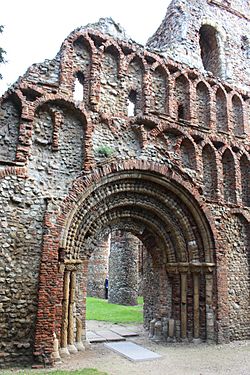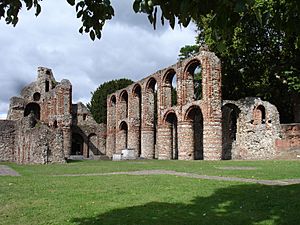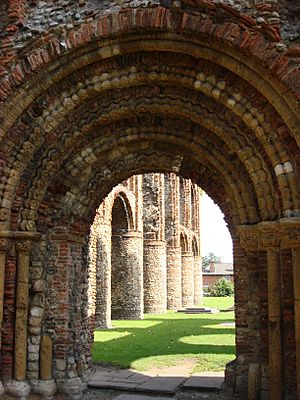St Botolph's Priory facts for kids

Pardon Door of the Priory Church
|
|
| Monastery information | |
|---|---|
| Order | Order of St Augustine |
| Established | c.1100 |
| Disestablished | 1536 |
| Dedicated to | St Botolph, St. Catherine of Alexandria |
| People | |
| Founder(s) | Ainulf |
| Architecture | |
| Status | Dissolved |
| Heritage designation | Grade I |
| Site | |
| Location | Colchester, Essex, United Kingdom |
| Coordinates | 51°53′15″N 0°54′17″E / 51.8874°N 0.9046°E |
| Visible remains | Large portions of the nave church |
| Public access | yes |
St. Botolph's Priory was an important religious house in Colchester, Essex, during the Middle Ages. It was home to a group of religious men called Augustinian canons. The priory was founded around 1093 and was the very first Augustinian monastery in England. It remained the most important one until it was closed down in 1536.
Today, the ruins of St. Botolph's Priory are protected as a special historical site. They are also a Grade I listed building, which means they are very important to England's history.
Contents
History of St. Botolph's Priory
How the Priory Started
Before the priory, an old Saxon church stood on the same spot. It was dedicated to St Botolph. The idea to turn this church into an Augustinian priory came from a priest named Norman. He had studied in France and then came to Colchester.
Norman met a group of priests at St. Botolph's church who wanted to join a religious order. Their leader, Ainulf, asked Norman for advice. Norman suggested the Augustinian order, which didn't have any monasteries in England yet. Ainulf and his followers agreed.
Norman went back to France to learn the rules of the Augustinian order. When he returned to Colchester, he and the other priests changed St. Botolph's church into St. Botolph's Priory. Ainulf became its first leader, called the Prior. This happened between 1093 and 1100. In 1116, Pope Paschal II officially approved the priory, making it the first Augustinian place in England. Besides St. Botolph, the priory also honored St. Julian and St. Denis.
Life in Medieval Times
Because St. Botolph's was the first Augustinian house in England, it was always considered the most important. It had special authority over all other Augustinian monasteries. The priory was also free from control by most outside people, whether they were kings or church leaders. When a Prior died, the monks would choose a new one.
In the mid-1300s, there was a big disagreement between St. Botolph's Priory and St John's Abbey. The Abbey complained to the Pope that the Prior of St. Botolph's and some of his monks had caused trouble. The Pope ordered the Archbishop of Canterbury to take action if they were found guilty. Luckily, these arguments were settled the next year.
In 1380, the Prior and monks complained to King Richard II. Some people were pretending to be from the priory and using fake letters to collect money from others. The king ordered these tricksters to be arrested.
By 1421, the priory had become quite poor, even though it was meant to support a Prior and twelve monks. Pope Martin V offered a special blessing to people who visited the priory on the feast of St. Denis and gave money to help repair it.
In 1434, Prior John Depyng left St. Botolph's to become the abbot of another priory. He took valuable items belonging to St. Botolph's with him. After he died, St. Botolph's tried to get their goods back, but they weren't successful.
The Priory's End and Later Years
In 1534, the Prior and seven monks swore an oath of loyalty to the King, as part of the First Succession Act. This helped them avoid trouble with the law.
However, the priory was officially closed down in 1536. This was part of a bigger event called the Dissolution of the Monasteries, when King Henry VIII closed many monasteries across England. The priory and all its lands were given to Sir Thomas Audley.
Because St. Botolph's was an Augustinian house, its church had two parts: one for the monks and one for the local people. When the priory closed, the part used by the monks (the choir) was pulled down. But the part used by the local community (the nave) was kept as a parish church.
This church remained until the Siege of Colchester in 1648, during the Second English Civil War. Royalist soldiers took over the town, and the New Model Army attacked it. St. Botolph's church was caught in the fighting and was badly damaged, leaving it in ruins as we see it today.
In 1837, a new church was built next to the ruins. Today, the ruins are a public park. Improvements were made between 2010 and 2012 to make them easier for everyone to visit.
The Priory Buildings
The Priory Church
The priory church was built in the Norman style on the site of the older Saxon church. It was finished by 1177. The church was very long, about 176 feet (53.7 meters), with a tower in the middle. The main part of the church, called the nave, was 110 feet (33.5 meters) long and 55 feet (16.75 meters) wide. The roof was about 45 feet (13.7 meters) high. It had a rose window, which is a round stained-glass window, and this was one of the earliest examples in England.
The church had several smaller chapels inside. One was a lady chapel dedicated to Mary, the mother of Jesus. Another was for St. Catherine of Alexandria. By 1281, there was also a chapel for St. Thomas Becket.
The main entrance to the church was called the Pardon Door. This was where people received special blessings or "pardons" on the feast day of St. Denis (October 9th). The monks' living areas, called cloisters, were on the south side of the church.
The priory was led by a Prior and usually had twelve monks, representing the Twelve Apostles. Later, a thirteenth monk was added to pray for a special person and his family. This monk also helped care for the poor.
What the Priory Owned
Even though St. Botolph's Priory was not as rich as its rival, St John's Abbey, it still owned a lot of land and property in Essex and other parts of England. Early on, King Henry I gave the priory some income from his own lands. He also gave them a share of a mill in Colchester.
Later, King Richard I gave the priory more rights and confirmed their ownership of churches in places like Gamlingay in Cambridgeshire, and Layer de la Haye and Marks Tey in Essex. These grants were confirmed again by later kings, Henry IV and Henry VI.
In 1291, the priory's yearly income from its lands was valued at about £42. This included money from Colchester, Layer de la Haye, Gamlingay, and other towns. They also earned money from churches they controlled in places like Hatfield Regis and Witham.
The priory also owned farms and mills around Colchester, including East Mill and Cannock Mill. These properties helped support the monks and their work.
Images for kids
See also






